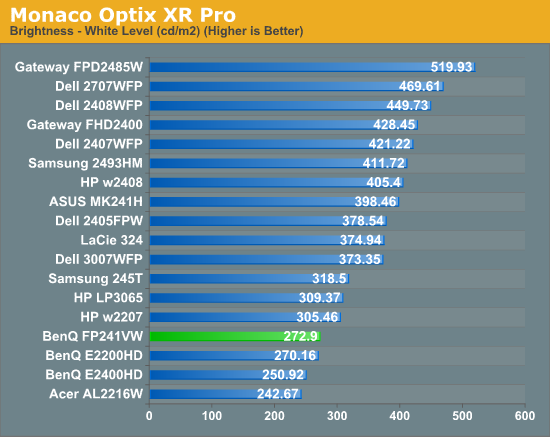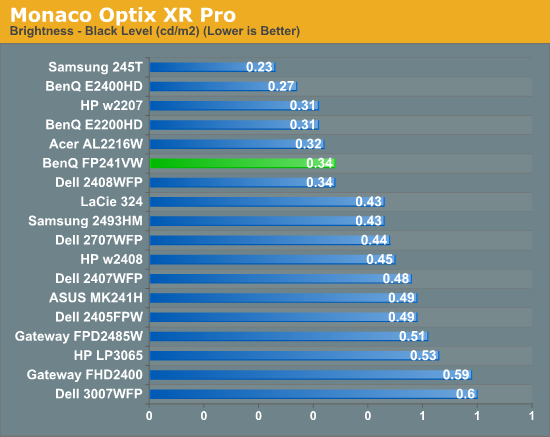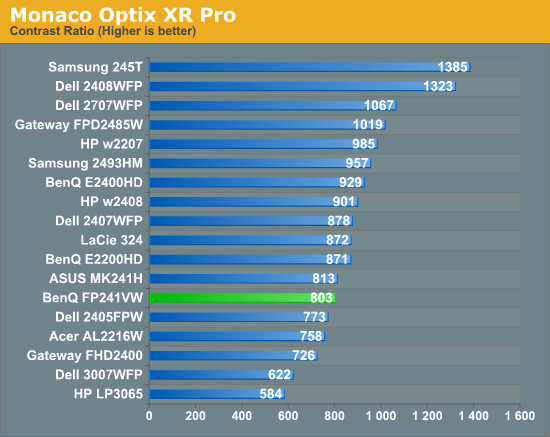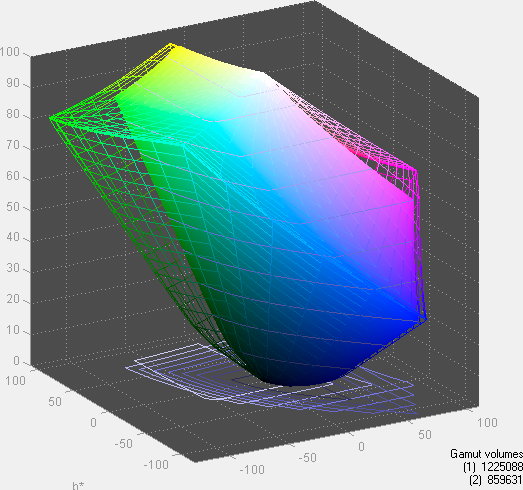Brightness and Contrast Ratio
For the brightness, contrast, and color accuracy tests, we depend on a hardware colorimeter and software to help calibrate the displays. We use a Monaco Optix XR (DTP-94) colorimeter and Monaco Optix XR Pro software, and we also test with ColorEyes Display Pro. Results in nearly every case have been better with Monaco Optix XR Pro, so for this article we're skipping the ColorEyes Display Pro results. We didn't perform a complete evaluation of the FP241VW, so we're missing maximum/minimum brightness results, but in general the display performs similarly to other LCDs.



Don't pay too much attention to the white/black graphs, as they are merely reference points for how the displays perform at certain settings. Like many other LCDs, the FP241VW has a "normal" brightness level of ~270 nits, which is more than sufficient and is actually brighter than what most users prefer to use in an office environment. You can reach the advertised 500 nits brightness if you adjust contrast and color levels as well. More important than brightness levels is the contrast ratio at the various settings. We measured a contrast ratio of 800:1 with the FP241VW, which is a decent result placing it in the lower mid section of our charts. While higher scores are better, in reality anything above 500 is sufficient for most users (i.e. the HP LP3065 that we like is at the bottom of the chart). Also, we wouldn't worry about any advertised dynamic contrast ratio numbers - at least not if you want consistent colors.
Color Gamut
Below is a comparison of color gamut for the LCDs we've tested. We use Gamutvision, a utility developed by Imatest LLC, to calculate color gamut. We compare the color profiles of the LCDs to the Adobe RGB 1998 color profile and report the results as a percentage - higher being better.


So far, color gamut has generally fallen into one of two categories: either +/-95% or +/-75%. Color gamut is determined almost exclusively by the backlighting, and the BenQ FP241VW falls short of other high-end LCDs in this area. In fact, it's at the bottom of the chart (though the difference between 70% and 75% isn't something you're likely to notice, so the bottom grouping essentially is a tie). For the original price, we would expect better, and if AU Optronics updates this particular panel we would definitely like to see a better backlight. Ideally, what we would like to see from more manufacturers is the use of LED backlighting - you can get extremely high color gamuts using RGB LEDs, and power requirements are also lower than traditional CCFL backlights. It's important to keep things in perspective, however: 70% may seem very low, but if you are using the standard sRGB profile (Windows' default) these LCDs look fine. It's only in applications like Adobe Photoshop with its expanded color space that you might notice a difference between the display color gamuts.










114 Comments
View All Comments
praeses - Wednesday, June 17, 2009 - link
After using this particular monitor as my primary display at home for well over a year I have fairly decent experience with it. Nearly all of my concerns are reflected in this review. Having said that there are a few aspects I would like to point out:The input lag varies significantly from inputs and resolution. Using DVI at 1920x1200 yields the lowest while analogue at any other resolution is significantly higher. Using any of the different lighting modes adds lag as well. For my purposes I have them turned off.
VGA also seems to be quite washed out. It has troubles with certain timings as well including XBOX360 where it cannot compensate for the overscan. The composite inputs are reasonable although when scaled any signal distortion is amplified significantly.
Of course, the fluorescent backlight is annoying. As a previous commenter has implied that using LCDs do not result in headaches, that is far from the truth. Once manufacturers move towards LED backlighting hopefully some of that will be alleviated. To date I have been unsuccessful at tracking down a suitable LED panel to swap into this monitor. The non-adjustable backlighting is also significantly annoying in low light conditions with some bleeding, although fairly consistent throughout the panel appearing gray.
The headphone connection only working for audio over HDMI just seems silly. They should have included an analogue pass-through.
Prior to purchasing this monitor I was aware of most of these issues and they are consistent between screens. Some people have buyer's pride and dismiss it or do not see them to begin with. Despite this, I am quite happy with this monitor and have not found a better replacement for my uses where viewing angles, input lag (over DVI), and composite inputs are paramount.
Spacecomber - Wednesday, June 17, 2009 - link
I think the reason that the trend with LCDs is simply to make them cheaper and not better has a lot to do with there being no meaningful specifications that the consumer can use to compare one monitor to another. In many cases, you can't even tell what kind of panel is being used. (Imagine buying a CRT monitor and not being able to easily tell whether it was a shadow-mask or an aperture grill tube.)With no meaningful information about the monitor in its technical specifications, the only thing the consumer can easily determine is relative price differences.
At this point, it is pretty clear that the industry manufacturing LCDs has no motivation to redress this on their own. I don't know who might be in the best position try to change this, but outside pressure (if not outright regulation) needs to be applied, if there is any hope of making manufacturers compete on a level playing field, when it comes to what a particular monitor really is capable of.
I suspect that respected professional computer hardware review publications, such as Anandtech, could wield some clout in pursuit of this end, and I hope that they pick up the banner.
darklight0tr - Wednesday, June 17, 2009 - link
I agree. The panel type should be disclosed in the specifications for all LCDs so the consumer knows what they are getting. Right now you have trudge through the bowels of the Internet just to find what panel is being used for a particular display, since most of the time it isn't disclosed.The technical specifications are also suspect because the "tests" used aren't standardized or controlled in any meaningful fashion. That's how you can have 2ms LCDs that really are 10ms or higher. Same thing with contrast ratios, especially dynamic ones. I'm just waiting for the LCD that has Infinity:1 contrast ratio. That's the one for me!
tomoyo - Wednesday, June 17, 2009 - link
Companies will never do this for one big reason. Profit. They profit from the lack of real specifications on lcds that allows them to make even low end lcds seem to be good. And most people don't care at all. We're the few that actually try to give good advice on avoiding crap lcds, but we can't fight against the huge tide of mindless consumers.JarredWalton - Wednesday, June 17, 2009 - link
Don't forget the other reason a lot of companies don't like to disclose the type of LCD panel they use: they don't want to be "locked in" to a specific LCD panel. If they were to advertise that the display uses, for example, an S-PVA panel, they wouldn't be able to switch to less expensive TN down the road -- or perhaps IPS or MVA. High quality displays generally don't change panels midway through the production run, but the same can't be said of less expensive models.tomoyo - Wednesday, June 17, 2009 - link
No kidding. I remember all that panel lottery madness with those Samsung TN-films such as the 226BW. It was ridiculous when there were 4 possible panels you could receive from one monitor model. Same thing with the Dell IPS/S-PVA lottery from long ago. It's dishonest how little they care about the quality of the product that we get.I'm glad my friend got a Benq FP241W with a similar MVA panel to the one you just reviewed a couple years ago for around $600. Probably the best pickup for a 24" at the time. (and he was lucky not to experience problems like some have).
alexdi - Wednesday, June 17, 2009 - link
The lag numbers for the Dell 2408WFP are incorrect as of revision A01, which replaced A00 four months ago. A01 lag is significantly reduced and identical to the 2407WFP A04. I have had all three screens at once to verify this.fmyhr - Wednesday, June 17, 2009 - link
http://www.kwiksurveys.com/online-survey.php?surve...">http://www.kwiksurveys.com/online-survey.php?surve...If you would like to be able to buy a ThinkPad or other business-class notebook with a premium screen, please take the survey at the above url when you can spare a couple of minutes.
Survey results are here:
http://forums.lenovo.com/lnv/board/message?board.i...">http://forums.lenovo.com/lnv/board/mess...al_Inter...
Thanks for your help!
GTaudiophile - Wednesday, June 17, 2009 - link
I spent a few months doing research, trying to find a 24" replacement for my really old DELL 2001FP.It more or less came down to the DELL 2408WFP and the HP LP2475w. But I just read too many negative reviews, calibration issues, etc. to feel that either was a safe bet of my $550.00 USD.
What am I looking for? 24". 1920x1200. 1080P. 16:9. Something "approved" by photographers for photo editing / color accuracy. But something that can also be a decent gaming monitor when needed. Something that will allow me to be on the net for hours without causing too much eye fatigue. And finally costs around $500 or less.
In the end, I quit my search for now, unsatisfied with current market offerings. If the "Stickied LCD" thread in the Video Cards & Graphics forum is any indication, I am not the only frustrated person out there.
haplo602 - Wednesday, June 17, 2009 - link
I want to buy the HP screen you mentioned. What negatives did you find about it ? I did only find favorable reviews.